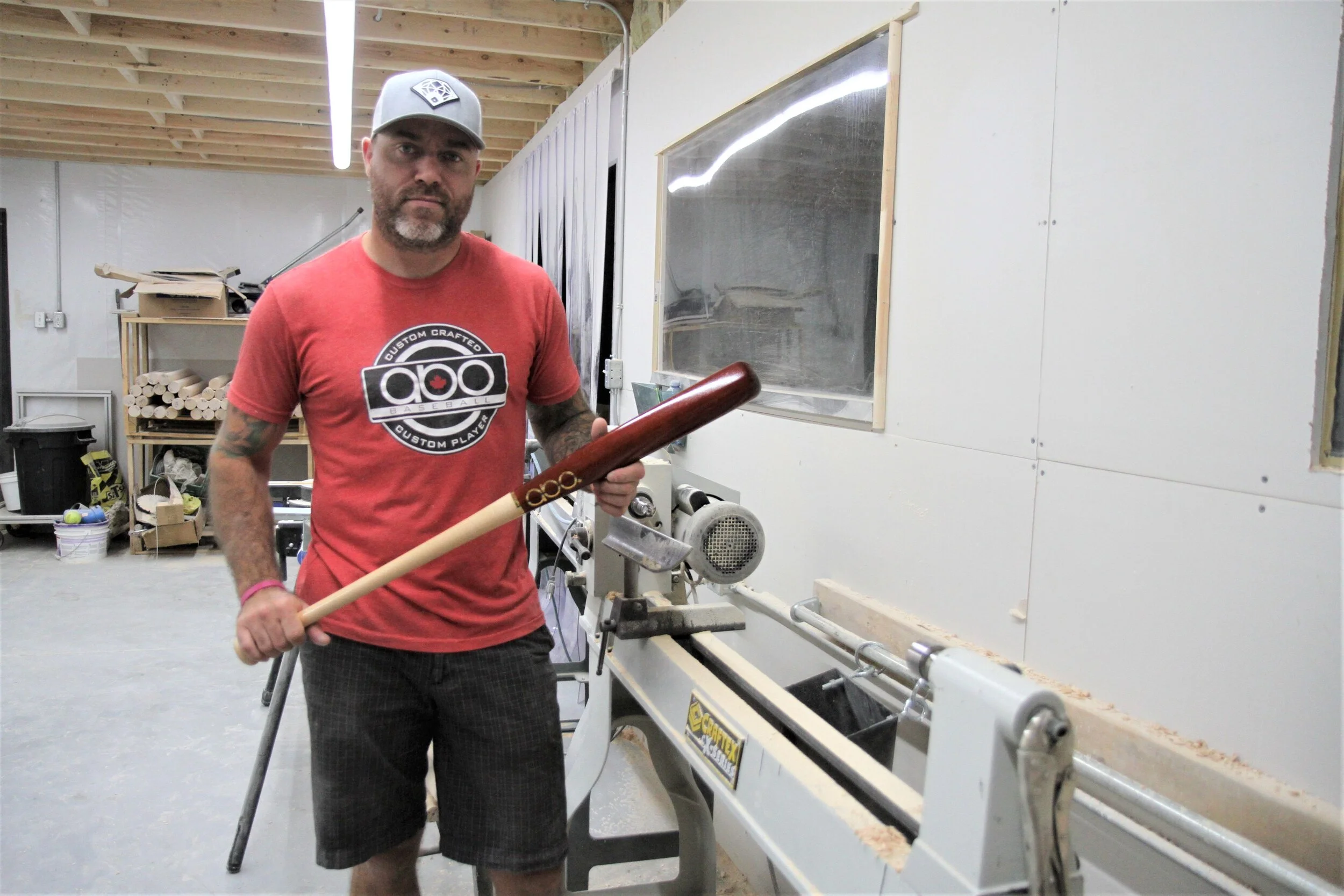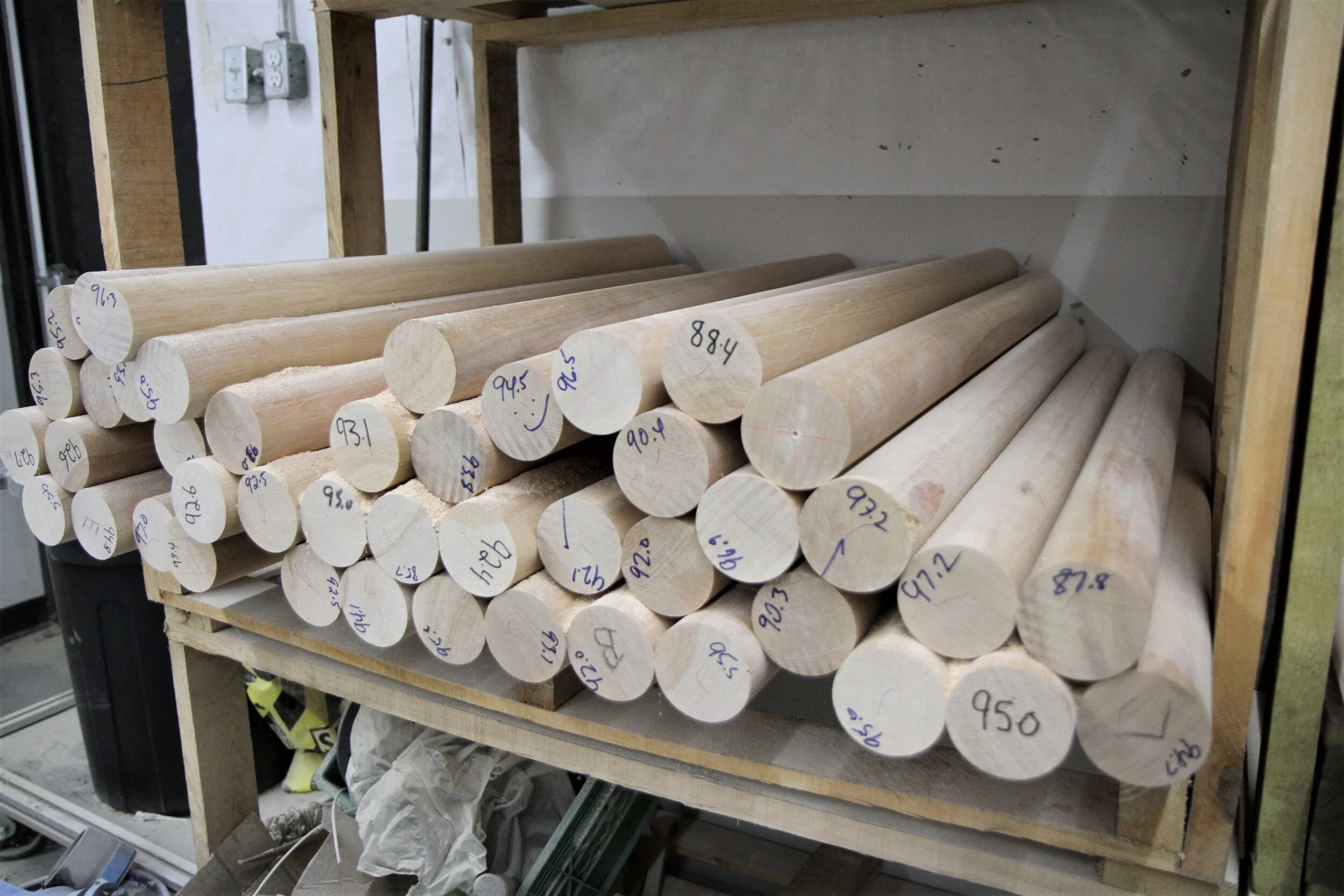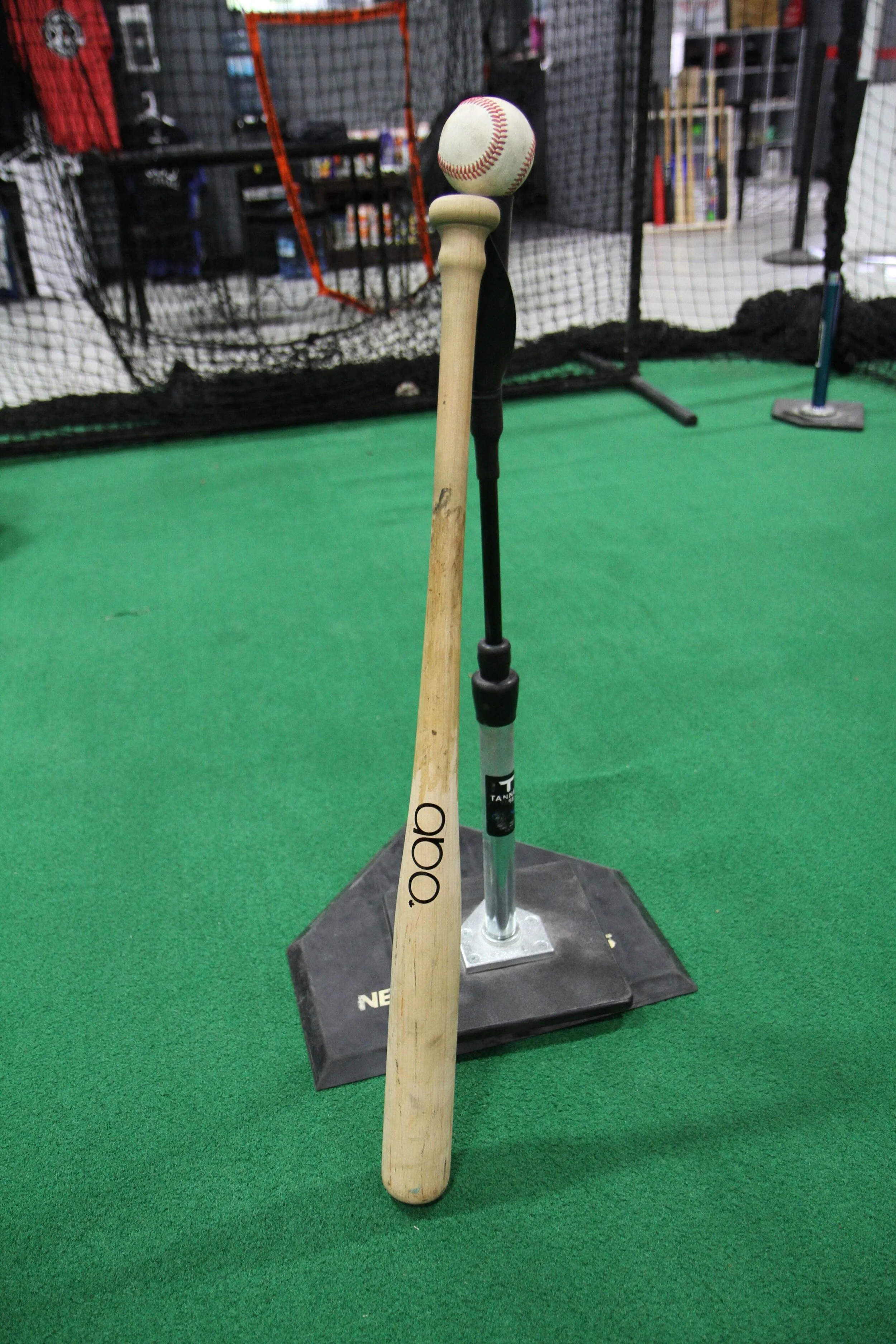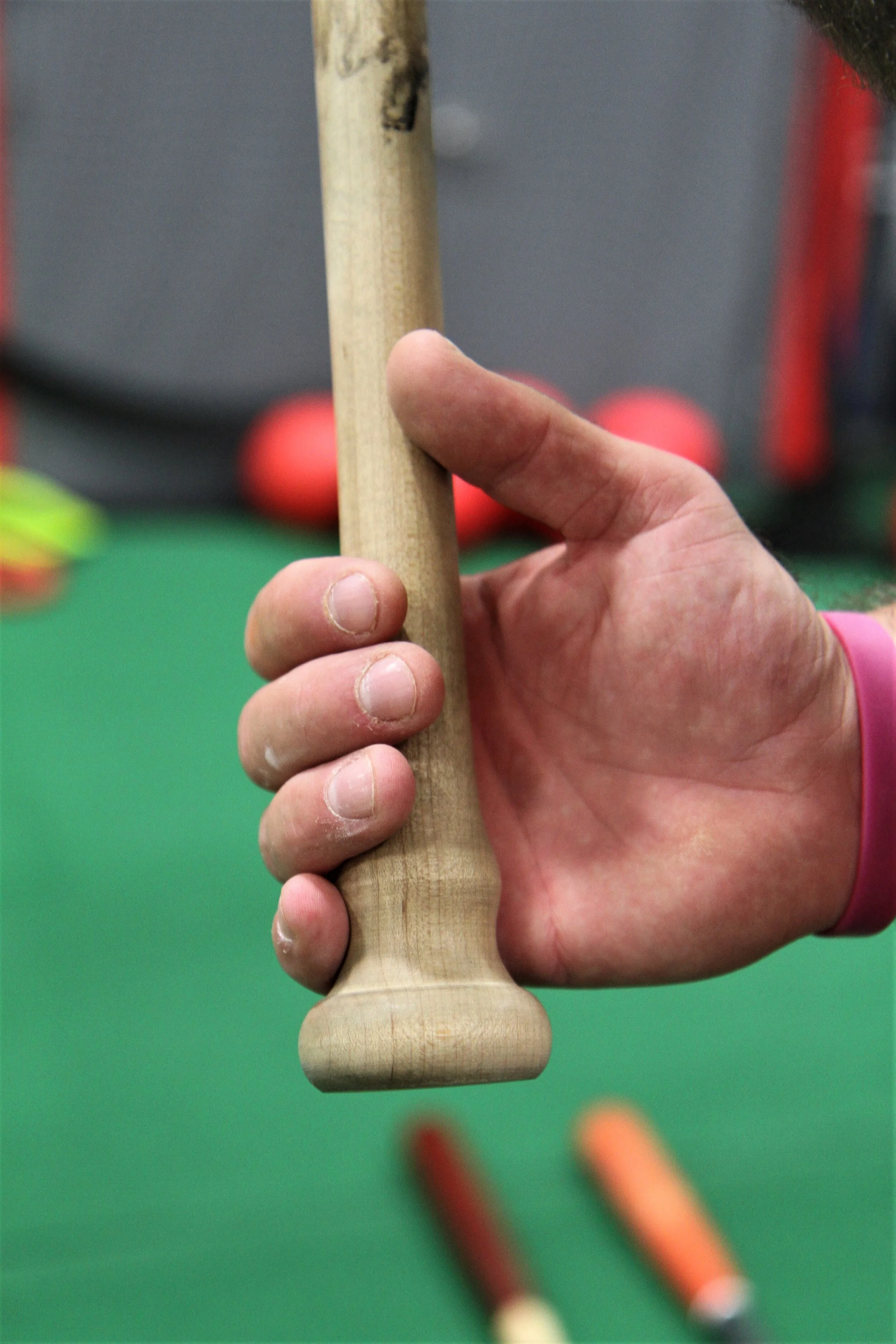Tillsonburg bat maker has big league breakthrough
Three years after launching his business, Tillsonburg, Ont. bat maker Trevor Oakes is on the official MLB supplier list and this summer saw one of his bats used in a major league game. Photo: J.P. Antonacci
September 24, 2020
By J.P. Antonacci
Canadian Baseball Network
As Los Angeles catching prospect Franklin Torres dug into the batter’s box, tapping his Canadian-made ABO Baseball bat on home plate, bat maker Trevor Oakes sat on the edge of his seat near the Angels dugout and prayed to the baseball gods.
“My heart was like, ‘please don’t break,’” Oakes said.
He needn’t have worried.
Torres swung at the first pitch and the maple bat Oakes hand-crafted in his Tillsonburg, Ont. workshop held up its end of the bargain, launching the baseball to left field for an RBI double.
“He hit a missile past (Colorado Rockies third baseman Nolan) Arenado,” Oakes said. “It was so amazing.”
That at-bat under sunny Arizona skies this past February marked an important milestone for Oakes. It was the first time one of his wooden creations was used in a professional game.
“It was the best feeling ever,” he said. “I’m getting goosebumps just remembering it.”
Four years before that fateful afternoon, the major leagues were far from Oakes’ mind. He was playing on a senior OBA team in his hometown and broke a few bats in quick succession. But instead of going to a sporting goods store for replacements, he went on Kijiji and bought a lathe.
“The original idea was to make me one or two bats and then we were going to make Christmas ornaments,” he said.
He hadn’t used a lathe since high school, but being mechanically minded, Oakes quickly got the hang of how to manoeuvre the wood and where to apply pressure to get the desired shape.
He finished his new bats and kept on going, selling on Kijiji and registering his business – named ABO Baseball after his two kids, Audrey and Brandon Oakes – in the spring of 2017.
Over the past four years, Oakes has handmade more than 5,000 bats. Photo: J.P. Antonacci
As a project manager at the Toyota plant in Woodstock, Ont., he routinely logged 12-hour days before working at his lathe late into the night to meet a growing demand.
“It came to a point where it was too much. I had to pick one,” he said.
Though it was a gamble to leave a steady job halfway to retirement, Oakes chose to pursue his new passion.
“I always would have wondered what would have been,” he said.
With his wife Catherine’s blessing, he rented a factory shop in Tillsonburg before opening his own place and welcoming clients like Tristan DesLauriers of the Oshawa Legionaires elite team, one of the first players to get on board with ABO.
“The feeling from the ball on contact just feels so much better. The wood is way better,” DesLauriers said, explaining that ABO bats don’t rattle.
“He knows exactly how to make a bat.”
It’s not just the bats that keeps DesLauriers coming back, or why half the Legionaires and dozens of Intercounty Baseball League players source their lumber in Tillsonburg. Oakes invites players into his shop and walks them through his process, refining their bat until it feels just right.
Players pick the wood – Oakes orders high-end maple and birch from a confidential supplier in Quebec – and Oakes guides them in customizing the knob, handle, weight distribution and barrel shape, taking care to stay within MLB guidelines.
Oakes sources his professional-grade maple and birch from a supplier in Quebec. Photo: J.P. Antonacci
There’s a batting cage on hand so players can try out their bat as soon as it comes off the lathe. They can hit off a tee or use a pitching machine, with the analytics tool HitTrax available to generate more data about their swing.
Using a tee or a pitching machine, players can swing their bat as soon as it comes off the lathe and offer feedback. Photo: J.P. Antonacci
“This is the part I love – showing the kids what making a pro stock bat is all about,” Oakes said. “They feel like they’re big leaguers.”
“The HitTrax and stuff, it’s great to have it there,” DesLauriers added.
Oakes said a lot of players opt for the same modification – his patented “comfort grip.”
He adds a groove near the base of the bat for players to rest their pinkie finger comfortably and avoid rubbing against the handle. Some rest their ring finger in the groove and wrap the pinkie around the knob.
The comfort grip is a hit, Oakes said. “Every player who touched it wanted this knob.”
Oakes has a patent on the “comfort grip,” a groove at the base of the bat for players to rest their pinkie or ring finger. Photo: J.P. Antonacci
Jason DesLauriers, Tristan’s father and VP of Baseball Oshawa, appreciates Oakes’ commitment to making each bat with care.
“He won’t let that bat go until it’s perfect. That says a lot as an independent bat maker,” said Jason, who was Oakes’ slo-pitch teammate years ago and was excited to support his new venture.
“The biggest thing is how proud we are to have a bat maker who’s local,” Jason said. “I think having that in the baseball community in Ontario is awesome.”
SWINGING FOR THE FENCES
Having already made a leap of faith to quit his job and become an entrepreneur, Oakes swung for the fences when he boarded a plane for Arizona in February to convince pro players to try a bat they’d never heard of.
But Oakes wasn’t exactly flying blind. Thanks to an introduction made at the MLB winter meetings in San Diego, Oakes had an invitation from a Chicago White Sox coach to set up a table at the club’s spring training complex in Glendale.
After that, his calendar was clear. So Oakes worked the phones, cold-calling other clubs and using his appearance at White Sox camp as proof he belonged.
Visits with the Rangers, Angels, Royals, and Dodgers followed, with Oakes leaving dozens of bats at each stop and getting valuable feedback from players.
“They couldn’t believe the sound and the pop of the maple and birch,” he said. “We just let the bats do the talking.”
Most ABO bats are made from maple, which has replaced the softer ash as the MLB’s wood of choice, due in large part to Canadian batmaking pioneer Sam Holman of Sam Bat. With exit velocity having grown in importance for evaluating hitters, swinging a harder bat can turn a 91 mph ground ball out into a 94 mph single through the hole.
“For minor league guys fighting for a job, three miles an hour could change your whole life,” said Oakes, who only uses professional-grade wood to ensure each bat he makes will deliver the hardest contact.
“Whether you’re an MLB player or a 13-year-old local player, you’re getting the same bat,” he said.
That spring training RBI double was a major milestone, made all the more special because Oakes’ family back home got to see it.
“It was the biggest thing for me to have them see their initials on TV,” he said of ABO’s namesakes, Audrey and Brandon.
Jason DesLauriers said he’s seen his friend beam the same way when he watches Tristan and his Oshawa teammates use ABO bats.
“Trev looks like that when he sees a kid swinging it and when he sees a pro swinging it,” Jason said. “He gets this big smile on his face and his eyes light up.”
After his success in Arizona, Oakes came home for a week to pick up more bats and plan ahead for Florida, where he’d lined up appointments with every club. Then the pandemic hit, and his contact with the Phillies – the first club he was to meet in Clearwater – called and said not to bother making the trip.
When spring training was officially called off, Oakes swallowed his disappointment and focused on the positives.
“We really did have a good first impression, and I think it would’ve led to more,” he said. “Now I know what to do and next year we’ll be stronger. I truly believe 2021 will be an explosive year for us.”
HANDS-ON APPROACH
Oakes didn’t have a front row seat this time, but he said it was still a thrill to see Australian speedster Aaron Whitefield, then with the Minnesota Twins, use an ABO bat in a major league game this summer. He still can’t quite believe his company is vying with Sam Bat and Louisville Slugger for space in dugout bat racks.
“It’s really, really quick,” Oakes said of his MLB debut. “I had a five-year plan and did it in three.”
He’s now focused on getting his bats into retail stores – ABO is currently stocked in Source for Sports in London – and into the hands of pro players like Padres draft pick Owen Caissie, who recently made the trip to Tillsonburg from his Burlington home to take some cuts.
Being on the official MLB supplier list helps his sales pitch, as does an endorsement from former major leaguer Rob Butler (East York, Ont.), now co-director of the Butler Baseball Academy, who said Oakes made “the best fungo I have ever used – it has amazing pop.”
Looking ahead to next season, Oakes has offered minor league players his pro wood bats at the price they typically pay for stock wood bats, which are of lesser quality. His strategy is to help players by giving them superior bats at affordable prices while hopefully generating more good chatter around the league about the new Canadian lumber.
“We may take a hit on cost, but that’s our marketing plan right there,” he said.
There’s a newly arrived high-tech CNC lathe in the shop, which will help Oakes make more bats because it can be programmed and left to run on its own.
But he’s at his happiest when making bats by hand – just him and the lathe.
“I like getting in there with my hands,” said Oakes, who after making more than 5,000 bats can turn out a customized bat in less than 15 minutes.
Using a lathe to churn out bats with less effort would be “boring,” he said. With a podcast on in the background, Oakes will happily spend hours sculpting pro bats destined for the diamond or decorative bats with hand-painted team logos, antique scoreboards, space scenes and whatever the client throws at him.
“That’s my jam. My getaway,” Oakes said.
“No other bat maker offers what I do, and I hope it stays like that.”





